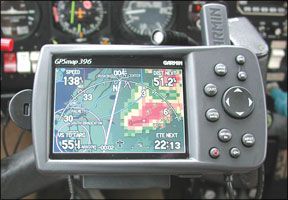Although they havent descended to the status of Cracker Jack prizes, by now, most owners have been through several generations of portable GPS navigators. What that means is that the bottomless-pit phase of GPS marketing is temporarily over. Manufacturers and buyers dwell in whats essentially a replacement/upgrade market. As a result, the pace of new product introduction has cooled. Garmins last major product was really the GPSMap 396 in 2005-the GPSmap 496 can reasonably be considered an upgrade of the 396, albeit a good one. With the market static and likely to remain that way, this may be as good a time as any to replace that old Garmin 195 or even something newer. If there’s any recent trend in GPS development worth noting, its price competition. As vendors scramble for sales in a volume-limited market, some are cutting prices to the bone or throwing in accessories as an edge against the competition. If price is your driving consideration, shop the Web; the deals are out there. Otherwise, buying a portable navigator in the current market is all about capability and how much you need and want. At the top end, the Garmin GPSmap 496 is essentially a portable EFIS with much of the capability of Garmins top-of-the-line G1000. At the bottom end, a $500 Lowrance AirMap 600C delivers accurate navigation, easy operation and a crisp color screen for one-fifth the price. Everything in between is, well, in between. We think there’s a product to match every budget and wish list and, in this article, we’ll examine the options. For space and simplicity, we are reviewing dedicated portables here. we’ll look at PDA and EFB-type solutions in a future article, including the AvMap products.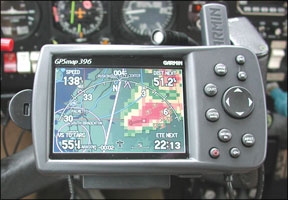
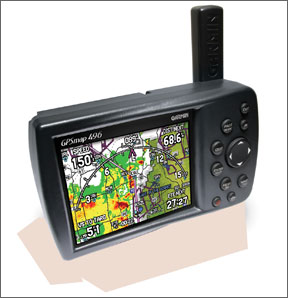
Price or Capability?
What drives the portable buying decision is a balancing act between price and capability. If money is no object, buy the Garmin GPSmap 496 and be done with it. It does it all and what it doesnt do, you don’t need. From that summit looking down, its the yin-yang of this versus that for more or less money. What constitutes “value” is defined differently by every buyer. Here are some major considerations to ponder: Is datalink weather important? If so, the choices are narrowed to the two top-tier Garmin models. How about ground navigation once youre at the destination? Both Lowrance and Garmin products do this, but Garmins turn-by-turn feature does it better, in our view.
Another feature is unique to four of the Garmin models: a sophisticated flight instrument page thats accurate and reliable enough to serve as a realistic backup to gyro instruments. (Weve tested this and were comfortable with the assertion.) Garmins three top-of-the-line color portables have this feature and so does the grayscale GPSmap 196.
While on the subject of color, do you need it or not? Weve grown accustomed enough to it to see its benefits, especially for terrain and weather depiction. Since
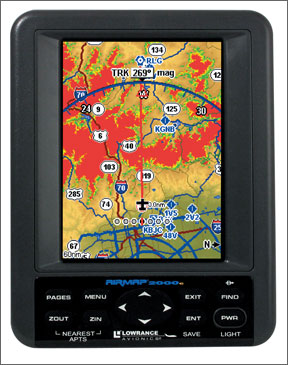
its available at affordable prices, we think its better to have it than not. Still, three models are grayscale only: Garmins GPSmap 96 and 196 and Lowrances AirMap 1000. All three have taken shades of gray to the ultimate evolution and are readable and crisp. Among the color displays, Garmins GPSmap 496 has the most vibrant, fastest refreshing display. With the fastest processor and highest terrain resolution, its noticeably better than the rest-and you pay for it in a high price.
While were impressed with all the high-level features aviation portables have, the reality is that many buyers don’t use them. Things like sunset tables, hundreds of user waypoints and customizable fields with dozens of choices are nice expressions of the software writers art, but they arent on our list of must-haves. More critical is the navigators operating logic. How easy is it to activate and find basic functions and those few higher-end gee-gaws you occasionally want?
Both Garmin and Lowrance figured this out long ago and both have stuck with operating logic thats learnable. Theyre definitely different, but we wouldnt say one is better or easier to use than the other. If you can operate one Garmin, you can operate any. Ditto the Lowrance navigators. Crossover users will need patience.
For instance, a Lowrance uses ZOUT/ZIN keys for scaling, a Garmin OUT or IN. The Garmins have a direct-to key, while Lowrance does it with a dual-duty Find/Direct
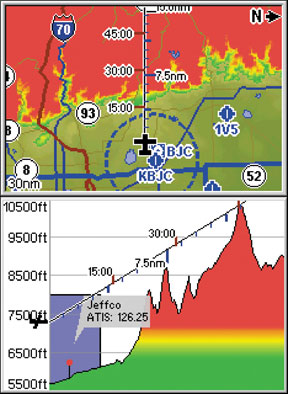
219
key. But both brands G and L have rocker, menu and enter keys which do sort of the same things. We occasionally hear complaints about Garmin operating logic being dense and impossible to learn. Frankly, we just don’t get that. Both brands have good instruction manuals and CD-ROM based training programs are available.
For some owners, what comes in the box for a standard price is a decision driver. If thats you, skip the bargain units in favor of high-priced products. Garmins GPSmap 496 ships in a giant box full of nearly every goodie the company has in the accessory catalog. Lowrance loads all of its models generously with accessories, including a charger, a card reader and a RAM yoke mount. At the other end of the spectrum, Garmins GPSmap 96 are a la carte. You get the navigator and some basics, but anything else is an added-cost extra.
What follows is our summary and highlights of current portable GPS choices evaluated with the realization that some of these designs are no longer cutting edge.
Garmin GPSmap 496
If, when we began covering GPS in 1991, anyone had predicted the advent of the $2995 portable, we would have said sure and why don’t you take a shopping trip
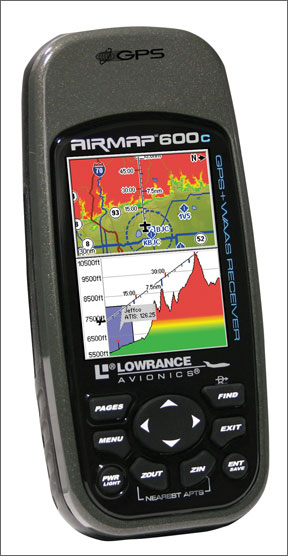
155
down to the psycho ward to pick one up? Yet here it is, albeit typically discounted to $2795. The 496 is the follow-on to the GPSmap 396 which first appeared in mid-2005.
Like its progenitor, the GPSmap 496 is the Swiss Army knife of portables, offering real-time datalinked weather, XM audio, SafeTaxi ground charts, AOPA Airport Directory and pre-loaded highway maps for ground travel. And, oh yeah, it navigates, too, complete with WAAS and most of the instrument approaches in the U.S.
So whats the big deal with this thing? Whys it so expensive? Shrewd marketing on Garmins part, for one thing, but its also new and improved over the GPSmap 396. It has a faster screen refresh rate-5 Hz versus 1 Hz-and a sharp, 256-color TFT color display. Although it looks crisper than the 396s screen, it really isn’t; the rapid refresh does that. But one thing is no illusion: it has three times more terrain resolution than the 396, so terrain depiction at some scales looks quasi-photographic rather than blocky, as on early color screens.
This is also noticeable when flying with the instrument page, which uses GPS-derived attitude information to effectively mimic a primary flight display. The 496s instrument page is more fluid than the 396s, but youd almost need to have them side-by-side to notice. With its detailed terrain and obstacle database and the ability to setup warning parameters, the GPSmap 496 really is a mini-EFIS with TAWs and weatherlink.
But is it a good value? It is if spending most of $3000 on a portable is affordable. Nothing touches the 496 in overall capability. Some buyers are wondering if Garmin is about to roll out the 596 at Oshkosh next month. They don’t tell us these things, but were not expecting it. What you see is what you get for the moment.
GPSmap 396
As a GPS company, Garmin has never lost its ability to wow buyers and it certainly did that with the GPSmap 396 in the summer of 2005. No one was expecting a
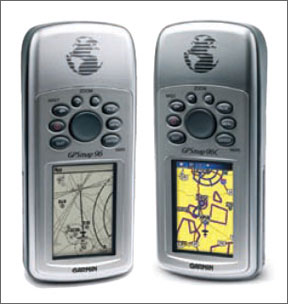
portable to have weatherlink, but the 396 does and it works well. In fact, weatherlink is the single best reason to buy a GPS that costs this much-$2195 discounted, typically.
When the 496 arrived in 2006, a modest flood of used 396s hit the market and some are still out there at $1700 to $1900, a good value. But if youre buying used, you might have limited or no warranty and as with all of its products, Garmin has a flat repair cost for the GPSmap 396. Its $375. If youre buying new at near this price, you’ll need to apply the sharpest part of the pencil to the differences between the 396 and the 496 and, frankly, they arent that great. If road navigation is a must, the 396 will do that, but you’ll need to buy Garmins mapping datasets and load them into the navigator via PC interface. Thats not difficult, but its an extra step you wont need if you buy the 496, whose maps are preloaded.
Functionally, the 396 and 496 are identical; they use the same hardware and same operating logic and both are powered by onboard rechargeable lithium-ion batteries, with no disposable battery option. Both also use the GXM30A Smart Antenna, which contains the XM chipset for data and audio. The GPS signal is snatched through either the standard stick antenna or a remote low-profile antenna, a standard accessory. In our review in the GPSmap 496 in the September 2006 issue, we concluded that the $600 price Delta between the 396 and 496 was offset by the added value of slightly better performance and the onboard road mapping and taxi charts, which you can get only in the 496. But if a good navigator with weatherlink is your basic requirement, the 396 remains the top value, in our view.
GPSmap 296
But what if weatherlink isn’t a requirement? Garmin has an answer to that, too, in the GPSmap 296. The 296 hit the market about a year before the 396 and, in our estimation, has been all but totally eclipsed by its more expensive stablemates. Buyers probably don’t realize that the 296 pioneered in a portable some of features Garmin was planning for the G1000 panel mount EFIS, specifically the look ahead terrain warning features found in TAWs.
When the GPSmap 296 debuted, it had a retail price of $1795, which caused us to draw a short breath. Following its usual MO, Garmin did its best to kill a year-old product with a new-and-improved version, thus the 296 is now found discounted to $1495. This makes it an oddball value, if you ask us. Thats still a pile of cash-nearly twice as much as GPSmap 196, but $700 less than the weatherlink-capable GPSmap 396. Obviously, Garmin isn’t wandering lost in the forest of pricing psychology. If you don’t fly in the weather much or at all, youre also probably a budget owner and you don’t need or want weatherlink. In that case, the 296 is strong on terrain functions, basic navigation and ground routing, so it isn’t a bad choice. But for the truly budget minded, we think there are better options.
GPSmap 196
And this is one of them. Color displays have become the standard, so much so that they tend to eclipse basic functionality. Although largely unsung because of its modest grayscale display, the GPSmap 196 has impressive capability at whats now at the low end of the mid-price spectrum. Introduced in 2002-the last ice age in GPS R&D time-this modest navigator showed what could be accomplished with ingenious software and not that much processing power. It introduced the flight instrument page and we used the 196 to prove that this feature could serve as gyro instrument backup by flying approaches under the hood.
Otherwise, the GPSmap 196 has all the basic features youd want, including instrument approaches and an obstacle database, but not the more sophisticated terrain database found in the 396/496, nor does it have audible terrain alerting. It will do turn-by-turn street navigation, but no voice prompts for that feature.
As grayscale screens go, its quite readable and a little better in direct sunlight than the color models, since there are no hues to wash out. The pixel density is twice that of Garmins earlier model 195, thus gray scaling is more subtle.
But heres where it gets complicated. The GPSmap 196 sells for $799 discounted, a bit more than Lowrances color AirMap 2000C, which has a larger screen, but doesnt do ground navigation as we’ll nor does it have the flight instrument page. Pricewise, the nearest fully featured Garmin model is $700 away in the GPSmap 296. A tough call, but if you want the flight instrument page cheaply, the 196 is a good option. If that isn’t important, you can get a large screen color portable from Lowrance for less money.
AirMap 2000C
And that would be the AirMap 2000C, Lowrances flagship product since 2005 and a much underrated product, in our opinion. While Garmins philosophy has been to pack increasing sophistication into the same form factors with mid-sized screens, Lowrance upped the ante with larger displays. As shown in our spec chart, the 2000Cs screen is fully a third larger than the Garmin color products and with similar pixel density, its just as sharp, although it doesnt refresh as quickly as the GPSmap 496. On the other hand, because of its size, the 2000Cs symbology and typography are large and easy to read.
The 2000C excels in screen variety, including a pseudo glass cockpit display that does some of what the Garmins flight instrument page does, although not quite as well, in our estimation. The Garmin pseudo-EFIS will keep you upright in the clouds, were not sure the 2000Cs would.
The screens are highly and easily customizable with lots of useful detail. We especially like Lowrances detailed taxiway diagrams and the screen is large enough to fully capitalize on the 2000Cs split screen function. At about $720 discounted, the 2000C is an excellent value, in our view.
AirMap 1000
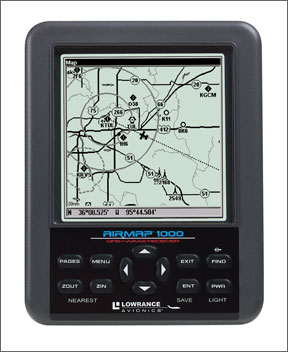
245
This model is Lowrances large screen entry in the grayscale display world and is the companys only non-color offering. Its really a grayscale version of the 2000C in terms of use of screen real estate and symbology and at under $500 discounted, its close to a give-away bargain, given its capabilities. (It debuted at $649, discounted.)
Like the 2000C, it has the pseudo glass cockpit display, split screen for dual mapping and practically unlimited flexibility in customizing the display. It doesnt have approaches in its database, but it does have extended runway centerline capability, which is excellent for locating airports in marginal VFR conditions.
The only downside to this product-and it applies to the 2000C, too-is that its physical size pushes the upward limit for most cockpits. In a constricted cockpit such as our Mooney, its almost too large. In a larger cockpit, say a Bonanza or Cessna 182, this is less of a worry.
Bottom Fish
Both Lowrance and Garmin troll the bottom of the price ziggurat with inexpensive starter navigators. Garmin has two, the grayscale GPSmap 96 and the color 96C, while Lowrance has the color AirMap 600C. (Some vendors are still carrying the mono Airmap 500, but Lowrance has officially discontinued it.)
When we reviewed portable navigators two years ago, we thought Lowrance represented the best value in rock bottom GPS and our view is that this is still true. But this time, the top value is the $499 AirMap 600C. It edges out the Garmin GPSmap 96C on price and provides vibrant color, good operability and even a modest EFIS, all at a low price. However, the Garmin 96 series win on two counts: We deem their cases and general hardware to be more robust and like everything in the Garmin line, theyll do sophisticated turn-by-turn navigation. The 600C cant do that.
What to Buy
Our research with vendors suggests that some owners buy more GPS than they need; they simply want the best gadget money can buy, cost be damned. That would be the GPSmap 496, hands down. Its packed with every imaginable feature and even if you don’t use the weather, the free road navigation and AOPA directory are plusses, even if a $2795 price tag isn’t.
Second choice? A tough call. But for the price conscious, the Lowrance AirMap 2000C has excellent capability and sells for a third of Garmins GPSmap 396. While the 2000C has no weather capability and trails the Garmins in ground navigation and pseudo-EFIS, its an excellent navigator with more features than even many power users will need. If datalink weather is a must and youre on a budget, the GPSmap 396 is our pick as the top value.

